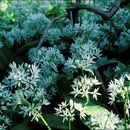Brief Summary
provided by EOL authors
Allium ursinum, known as ramsons or wild-, broad-leaved-, wood- or bear's garlic, is a monocot bulb-forming perennial plant native to Europe and Northern Asia, related to garlic (A. sativum) and chives (A. schoenoprasum). The Latin species epithet, “ursinum,” refers to bears—according to legend, ramsons is the first plant bears eat when they emerge from hibernation. Ramsons have broad leaves, to 4 cm wide and 30 cm long. Bulbs form from the base of a single leaf petiole (Tutin 1957). Plants typically have 2 or 3 leaves, but older, well-established plants may have more (Ernst 1977). The plants flower before deciduous trees leaf out in the spring. The scapes (leafless flower stems) are two- or three-angled, and the umbellate garlic-scented flowers produce capsules with seeds, rather than bulbils (aerial bulblets) typical of related species such as crow garlic (A. vineale) and field garlic (A. oleraceum). Ramsons grow in deciduous woodlands with moist soils, and often occur in monotypic stands, reproducing vegetatively as well as by seed. Observers have suggested that ramsons may inhibit competitors by producing allelopathic chemicals (toxic to other plants); like other members of the genus, the species produces organic disulphides that can inhibit plant growth. Ernst (1977), however, did not find evidence of allelopathy, but found that the heavy seeds, which are dispersed close to parent plants, have a low self-thinning rate, which could lead to dense stands. Ramsons leaves are edible and are used as a salad, an herb to flavor other dishes, boiled as a vegetable, in soup, or as an ingredient for pesto in lieu of basil. The stems are preserved by salting and eaten as a salad in Russia (Wikipedia 2011). Flowers or buds can be eaten in salad, and the bulbs are also edible. In Germany, ramsons are eaten as a spring tonic, to cleanse the system. Ramsons produce sulfide compounds similar to those found in garlic and onions, and appear to have similar medicinal effects, including antifungal and antimicrobial properties and cardiovascular benefits (Fern 2011, Koch and Lawson 1996). Studies have documented that its antiplatelet activity (which guards against cardiovascular disease), is similar to that of garlic (Hiyasat et al. 2009), and that it may reduce cardiac arrhythmias (Rietz et al. 1993). Ramsons have increased in popularity in recent years, and are widely collected from the wild in northern Europe. The plants are grown in home gardens (from bulbs or seed), but not commercially. Ramsons leaves are sometimes mistaken for those of three unrelated toxic and potentially deadly plants: lily-of-the-valley (Convallaria majalis); autumn crocus (Colchicum autumnale); and wild arum (Arum maculatum). In contrast to the poisonous species, ramsons leaves emit a garlic smell when broken or rubbed. Ramsons leaves each emerge from a separate green stem, whereas Convallaria majalis leaves grow on a single purple stem, and Colchicum autumnale leaves grow in a whorl from a single base. Arum maculatum have irregular edges and many deep veins, while ramsons leaves are convex with a single main vein (Wikipedia 2011).
- license
- cc-by-nc
- copyright
- Jacqueline Courteau

